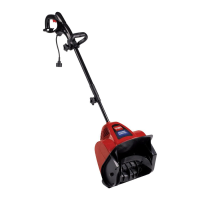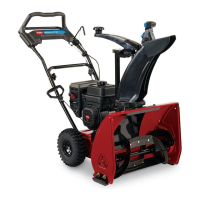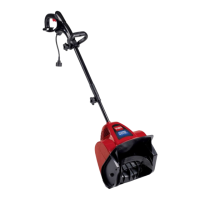Stopping the Engine
T o stop the engine , tur n the ignition k ey countercloc kwise
to the Off position ( Figure 16 ).
Figure 16
Starting the Rotor Blades
T o star t the rotor blades , squeeze the control bar to w ard the
handle until the sno wthro w er begins to pi v ot ( Figure 17 ).
Figure 17
Stopping the Rotor Blades
T o stop the rotor blades , release the control bar ( Figure 18 ).
Figure 18
Note: W hen y ou release the control bar , the rotor blades
stop , but the engine contin ues to r un.
Starting the Traction Drive
T o star t the traction dri v e , slo wly squeeze the control bar
to w ard the handle . T he front of the sno wthro w er pi v ots
do wnw ard. W hen the rotor blades touc h the g round,
the sno wthro w er begins to mo v e forw ard. Squeezing the
control bar completely to the handle pro vides maxim um
traction.
Stopping the Traction Drive
T o stop the traction dri v e , par tially release the control bar
until the rotor blades lift off the g round, diseng aging the
traction dri v e . R eleasing the control bar completely stops
both the traction dri v e and the rotor blades .
Adjusting the Discharge Chute
T o adjust the disc harg e c hute , mo v e the c hute handle and
the c hute deflector handle as sho wn ( Figure 19 ).
Figure 19
1. Chute handle 2. Chute deector handle
Preventing Freeze-up after Use
• Let the engine r un for a few min utes to prev ent mo ving
par ts from freezing . Stop the engine , w ait for all
mo ving par ts to stop , and remo v e ice and sno w from
the sno wthro w er .
• With the engine off , pull the recoil star ter handle
sev eral times and push the electric star t button once
(if applicable) to prev ent the recoil and electric star ters
from freezing up .
Operating Tips
T he r otor blades can thr o w stones, toys, and other
f or eign objects and cause serious per sonal injur y to
the operator or to bystander s.
• K eep the ar ea to be clear ed fr ee of all objects that
the r otor blades could pick up and thr o w .
• K eep all childr en and pets a w ay fr om the ar ea
of operation.
• R emo v e the sno w as soon as possible after it falls .
• T he sno wthro w er clears do wn to the g round and
propels itself forw ard when y ou eng ag e the traction
dri v e .
• If the sno wthro w er does not propel itself forw ard on
slipper y surfaces or in hea vy sno w , push forw ard on
the handle , but allo w the sno wthro w er to w ork at its
o wn pace .
• Ov erlap eac h sw ath to ensure complete sno w remo v al.
9

